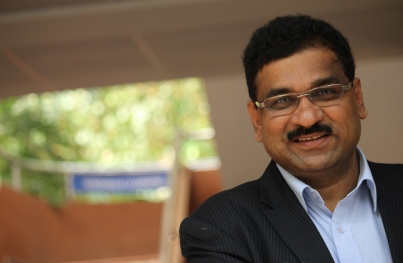The volatility in the markets must be viewed as yet another opportunity to invest in the India story
BFSI Industry Interview

Mr. Krishna Kumar is the Chief Investment Officer of Equities at Sundaram Asset Management Company. He is the Fund Manager of Sundaram Select Mid Cap, Sundaram S.M.I.L.E, Sundaram Select Small Cap Series, Sundaram Select Micro Cap Series, Sundaram Tax Saver, Sundaram Value Fund.
Krishna Kumar is a BE from Regional Engineering College, Trichy (now National Institute of Technology) and a PGDBA (Financial & Portfolio Management) from LIBA, Chennai, has close to 27 years of experience, of which 20 years are in Equity Markets.
He joined Sundaram Mutual in December 2003 as Equity Research Head before moving in to the fund management team. His previous experience includes 6 years in Lucas TVS and 7 years in Anush Shares & Securities.
In an interview with Advisorkhoj, Mr. Krishna Kumar discussed the various local and global factors and his take on Indian equities. His advice to retail investors is not to get deterred by bouts of volatility (correction) in the markets and must see it as yet another opportunity to invest in the India growth story. He also feels that, SIPs and STPs are well tried and tested methods of investing in a disciplined fashion and also that investing is all about discipline and not about market sentiments and emotions.
The market has rallied after the recent Budget. Apart from sticking to the fiscal deficit target, what other positives do you see in this Budget? What are some areas, if any, where you were disappointed?
The budget had to do a balancing act between weak rural health, uncertain external growth outlook, beleaguered banking system and expectation of infrastructure investment taking off in right earnest. In light of such contrasting challenges, the finance minister has done a commendable job in adhering to fiscal discipline. Not only was FY17 fiscal deficit target adhered to, government has further enumerated FY18 and FY19 goal of 3% fiscal deficit target. We believe this is a strong signalling to the investment community about robust and consistent growth that India Inc. has to offer. While absence of any big bang announcements may disappoint some people, we believe that the budget offers a pragmatic roadmap. The government has taken ownership for improving rural health, while they have left the infrastructure development to the states in the spirit of federalism.
The budget, like any other government announcement, must be read in context. Given the gloomy global backdrop, the simple act of the government to take on fiscal pain; when they could very easily have justified fiscal slippage, reflects resolve. And this must be appreciated.
Do you think that the Nifty had bottomed out at 6800 – 6900 levels and now stable at 7800+ levels? Or is there a risk of the market retesting those levels again and possibly going lower? What are the major risk factors for the Indian equity market form here onwards?
Talking about the Nifty in terms of levels would reflect a certain trading mind-set. India is a much bigger secular story and any correction one sees in the market is nothing but an opportunity to invest. This is how we believe investors must view the markets.
The Indian markets over the last couple of years are more closely linked to global developments than domestic. The domestic macro has seen significant positive changes in the fiscal, monetary and reform spaces and this is clearly reflecting in the India differentiation story within the emerging market pack.
We find that the top 5 sectors for almost all the AMCS are now Banking and Financial, Construction, Technology, Services and automobiles. Are you going to follow the same sector allocation trends for your funds? If no, then what other sectors you are bullish on? If yes, do you still think more is expected from these sectors?
We are positive on cyclical sectors that feed on the economic recovery theme like industrials, engineering & capital goods, transportation and financials. Infrastructure will be an important part of our portfolio taking into account the government's proposed spending in the sector. Private sector banks and NBFCs have been able to focus more on consumers / retail loans with strong control on spreads & credit costs. Herein again, we will allocate funds to this space, run by good managements. The urban consumer discretionary space looks good from a medium term perspective given the pay commission and OROP benefits. The Govt.’s renewed focus on the rural and farm sector particularly on back of expectations of a better monsoon this year is another theme we could play.
For the benefit of our readers, please also give us your outlook on the stressed assets problem in the public sector banks? What would be the role of The Bank Board Bureau (BBB) announced by the NDA government to improve governance at public sector banks?
PSUs have been corporate / wholesale lenders and they have been hit by the various stresses that have hit the global cyclical companies, infrastructure companies, etc. The overall stressed assets in the system could be to the tune of 12-14% of the loans. Complete recognition of the losses, provisioning and capital infusion are in progress. We see that this pain continuing into the next six months also. I think it may be a good time where you can start to selectively add PSU banks; from say June to September, October is when we probably will see lot more confidence coming back.
The Bank Board Bureau will comprise Chairman and 6 more members of which 3 will be bureaucrats while the rest would be bank experts. The BBB will drive the process on all board appointments, including those of Chairman and Executive Directors, provide inputs on differentiated strategies for bank transformation, advice on capital raising. The BBB would also be responsible for improving / consulting on psu banks’s HR strategy too. Most importantly the consolidation amongst PSU banks will be driven by this Bank Board Bureau.
Some experts proclaim that we are still in a new secular bull market run (even though the Indian stock market corrected by 18 – 20% from its last peak). While some are more guarded as they feel the recent run up is a hype rally only and soon settle to realistic levels. What is your take on the current market and what do you see as the key drivers for markets in the next three to five years?
Frankly, both are right! While we believe that India is set to witness a secular bull run in the years to come, one must remember that every bull run is interspersed with bouts of volatility, along with price and time corrections. What better time than this can an investor ask for. Disciplined investing through the well time-tested SIP and STP routes would be the formula to stable and successful returns.
2016 is a year of volatility for the markets mainly on account of the evident divergence in the monetary policies of the large central banks of the world. The last two policies of the Federal Reserve (Fed.) see increasing acknowledgement of global weakness. This weak backdrop is toning down the language of the Fed from its earlier hawkish one. Adding to the tone on weak global growth are the European Central Bank (ECB) and the Bank of Japan (BoJ), which are into the realm of negative interest rates. While a marginally dovish Fed. language and increasing acceptance of negative interest rates are a sign of muted global growth, it also brings with it some EM attention. It is here that India stands differentiated on the back of its macro strength, fiscal prudence and incremental space for monetary accommodation.
The month of March saw this differentiation play out within the EM space. Continued commodity stability along with currency stability is set to deepen the India differentiation story further, within the EM pack.
Last month the US Federal Reserve issued a dovish statement. How long do you think the Fed will wait before raising rates again?
Like mentioned earlier, the last two policies from the Fed. have seen increasing acknowledgement of the inability to continue raising rates, given the muted global backdrop. US growth remains strong in the services segment, but manufacturing remains weak. Therefore, it would be difficult to conceive of a sustained rate hike cycle at this point. The next couple of Fed. monetary policies however remain key to judge both the committee’s language and preparedness to deliver another 25bps of rate hikes in 2016.
The Fed statement last month indicates concerns with the US GDP growth and also global risks. What impact will the US economic outlook and other global macro-economic factors have on the Indian economy and equity market?
India is a largely a domestic-driven economy. Most of its growth drivers are domestic in nature. Having said that, global growth is equally important. We live in a globalised world and what happens in Beijing, Tokyo, Brussels or Washington does impact us; either directly or indirectly.
How much room does the RBI have for rate cuts in FY 2016 – 2017? What is the quantum of rate cuts that you expect in FY 2017?
We expect the RBI to deliver another 25bps cut on the Repo rate. This is based mainly on the expectation of a good monsoon season. Even if the monsoons disappoint, we would hold on to this incremental 25bps; more for growth.
Commodity prices have shown some improvement in the last few weeks. Can we say that the bear market in some of the major commodities is over or is it way too early to say such a thing? How will commodity markets affect Indian equities in 2016?
It would be too early to say that. However, one can say with a fair amount of conviction that commodity prices are not expected to see a sharp upswing from here. They are expected to remain relatively range bound to soft. And this very backdrop is India-positive both in the short term and in the long term.
Do you expect to see a recovery in corporate earnings during FY 2016-17?
Clearly the last 2 years have been disappointing from the perspective of corporate earnings growth. The sharp cut is seen in the earnings of the sectors linked to global cyclicals impacted nifty earnings. Nifty ex global cyclicals & psu banks is seeing a 8-10% earnings growth. As we see now, FY17 earnings growth could be upwards of 12-13% given the fact that the weakness in commodity earnings is already into the base.
Sundaram AMC has a very strong track record of performance across its MICRO Cap Funds Series. After the subdued performance of the markets over last one year, do you think there are still enough opportunities in this space?
Absolutely yes. The bottom end of the markets have seen a sharp cut in the last 6-8 months and valuations are very reasonable again. As investors see stability around, we see this microcap segment to rebound well.
The performances of your Midcap Fund has been stellar and one of the oldest and the best in its category. It is quite popular amongst IFAs and Investors and we understand it has a robust SIP book. Are you proposing any changes in the scheme in keeping tune with the recent market trends? What broadly will be your style and strategy going forward considering the fact that the expectation from this scheme is quite high!
The investment philosophy run on a 5S model, GARP valuation frameworks and the bottom up stock selection are key to its successful performance over the decade and we don’t intend to change any of them. Investing through the 5S approach means we go for simple businesses which operate in an environment of scalable opportunities under sound managements/promoters with certain sustainable competitive business advantage, leading to steady and growing cash flows, return ratios which in turn take care of all stake holders expectations.
What is your advice for the retail Mutual Fund Investors? What they should do now and how to invest in the current volatile market situation
Like I said earlier, every bout of volatility (correction) in the markets must be viewed as yet another opportunity to invest in the India story. SIPs and STPs are well tried and tested methods of investing in a disciplined fashion. Investing is all about discipline and not about market sentiments and emotion. Look at longer time horizons for investing. This way, you give your investments more time and room to mature and grow.
Recent Interviews
-
Partner Connect by Advisorkhoj with Mr Amit Kalra Glorious Path Pvt Ltd New Delhi
Dec 5, 2025
-
Partner Connect by Advisorkhoj with Mr Alok Dubey PrimeWealth Pune
Dec 1, 2025
-
In Conversation by Advisorkhoj with Ms Aparna Shanker Chief Investment Officer Equity The Wealth Company Mutual Fund
Nov 28, 2025
-
In Conversation by Advisorkhoj with Mr Sanjay Bembalkar Head Equity Union MF
Nov 28, 2025
-
In Conversation by Advisorkhoj with Mr Arjun Khanna Equity Fund Manager Kotak Mutual Fund
Nov 17, 2025
Fund News
-
Sundaram Mutual Fund launches Sundaram Income Plus Arbitrage Active FoF
Jan 5, 2026 by Advisorkhoj Team
-
Kotak Mahindra Mutual Fund launches Kotak Dividend Yield Fund
Jan 5, 2026 by Advisorkhoj Team
-
Motilal Oswal Mutual Fund launches Motilal Oswal Diversified Equity Flexicap Passive Fund of Funds
Jan 2, 2026 by Advisorkhoj Team
-
Mr. Navneet Munot's 'Person of the Year 2025'
Dec 31, 2025 by HDFC Mutual Fund
-
Zerodha Mutual Fund launches Zerodha Nifty Short Duration G Sec Index Fund
Dec 26, 2025 by Advisorkhoj Team





